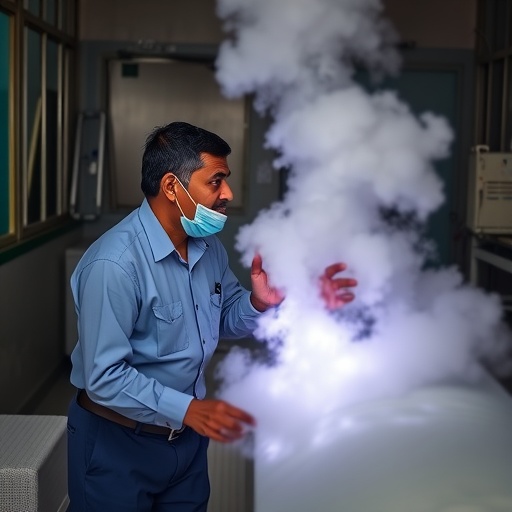In the midst of the global COVID-19 pandemic, India faced an unprecedented crisis in healthcare management, especially concerning oxygen supply and distribution. The pandemic not only highlighted the critical need for efficient oxygen management but also exposed systemic vulnerabilities in healthcare infrastructures across the nation. As cases surged, the demand for medical oxygen skyrocketed, leading to shortages that severely impacted patient outcomes. The research conducted by Singh, Dhir, and Kasar provides an insightful exploration into the dynamics of oxygen management challenges that arose amidst the pandemic and offers a modified Total Interpretive Structural Modeling (m-TISM) approach for navigating these issues.
As healthcare facilities struggled under the burden of rising cases, the primary challenge was ensuring a consistent and adequate supply of oxygen. Hospitals quickly realized that the traditional methods of managing oxygen supply chains were insufficient in the face of the acute demands presented by COVID-19 patients. The inefficiencies in logistics, procurement, and distribution underscored the necessity for a more structured approach to oxygen management. The research encompasses a comprehensive analysis of the complexities involved in the supply chain, identifying various stakeholders including manufacturers, suppliers, hospitals, and governmental bodies.
The implementation of m-TISM allowed researchers to map out the interrelations among the different components involved in oxygen management. By delineating the intricate connections between these elements, the study illuminated the root causes of supply chain disruptions. Singling out factors like regulatory hurdles, transportation challenges, and fluctuating demand patterns provided a clear picture of where interventions were most needed. The findings suggest that oxygen supply chains must operate with agility, capable of adapting to real-time changes in demand, particularly during health crises.
Alongside the logistical challenges, administrative barriers also posed significant obstacles to effective oxygen management. Strengthening inter-agency coordination was identified as a critical component to overcome these barriers. The need for seamless communication between health authorities, emergency services, and private sector participants is essential in not only managing existing supply but also forecasting future needs. The study emphasizes that without a collaborative framework encompassing all stakeholders, the oxygen management system would remain frail and reactive rather than proactive and resilient.
Another pivotal aspect discussed in the research pertains to the role of technology in optimizing oxygen management systems. The potential for integration of information technology, including data analytics and monitoring tools, could enhance decision-making processes by providing timely insights into consumption patterns and inventory levels. Such advancements could facilitate predictive modeling, enabling healthcare providers to allocate resources efficiently, particularly during surges in patient admissions. Moreover, technology can assist in streamlining the procurement process, thus minimizing wastage and enhancing accountability in the distribution of oxygen supplies.
As the research articulates, the insights gleaned from the COVID-19 pandemic should not merely serve as a retrospective analysis but should actively inform future strategies in healthcare management. By adopting a modified Total Interpretive Structural Modeling framework, stakeholders can implement more robust systems that withstand the pressures of emergent situations. It also calls for national policy frameworks that explicitly account for rapid response mechanisms in health emergencies, ensuring that critical resources like oxygen are consistently available.
In navigating these challenges, the study makes a case for a paradigm shift in how healthcare systems perceive resource management. It advocates for an emphasis on preventive strategies, rather than reactive measures that only kick in during a crisis. By fostering a culture of preparedness and resilience, health authorities can better manage resources, especially in times of heightened demand. This proactive approach is crucial not just for pandemic preparedness but for overall healthcare service delivery across regions.
Patient care quality hinges on effective oxygen management; thus, the implications of the study extend to new healthcare delivery models. Hospitals must reevaluate their internal protocols and collaborate with external suppliers to ensure that the flow of oxygen is consistent and reliable. Given the life-or-death stakes involved, stakeholders must advocate for transparency and efficiency at all levels of the supply chain, thereby enhancing the overall functioning of the healthcare system.
As researchers and health officials look beyond the immediate aftermath of the pandemic, the importance of robust oxygen management frameworks cannot be overstated. Future research avenues can explore innovative solutions, addressing operational challenges while embracing the technological advancements available today. Moreover, implementing m-TISM and similar methodologies in other resource management fields may yield beneficial insights that transcend the healthcare domain, impacting various sectors reliant on critical supply chains.
Lastly, it is crucial for policymakers to prioritize investment in healthcare infrastructure that supports sustainable oxygen management practices. Strategies must be deployable at local, state, and national levels, ensuring that the lessons of COVID-19 lead to lasting improvements in health emergency preparedness. This focus on adaptive capacity and resource allocation will ultimately not only save lives during crises but also enhance the everyday functioning of healthcare services, making them robust and capable of meeting the challenges of tomorrow.
In conclusion, the research by Singh, Dhir, and Kasar delineates the complexities of oxygen management that surfaced during the COVID-19 pandemic. It serves as an essential resource for comprehending the multifaceted challenges that need to be addressed to refine healthcare response mechanisms. By leveraging structured methodologies like m-TISM, stakeholders can navigate the intricate landscape of resource management more effectively, paving the way for better health outcomes in the face of inevitable future challenges.
Subject of Research: Oxygen management challenges in India during the COVID-19 pandemic
Article Title: Navigating oxygen management challenges amidst COVID-19 pandemic and beyond in India: a modified Total Interpretive Structural Modeling (m-TISM) approach
Article References: Singh, M., Dhir, S., Kasar, J. et al. Navigating oxygen management challenges amidst COVID-19 pandemic and beyond in India: a modified Total Interpretive Structural Modeling (m-TISM) approach. BMC Health Serv Res 25, 1463 (2025). https://doi.org/10.1186/s12913-025-13655-z
Image Credits: AI Generated
DOI: https://doi.org/10.1186/s12913-025-13655-z
Keywords: Oxygen management, COVID-19, healthcare infrastructure, m-TISM, resource allocation, health emergencies, technology in healthcare, supply chain management
Tags: COVID-19 healthcare challengeshealthcare infrastructure improvementsm-TISM application in healthcaremanaging oxygen shortagesmedical oxygen supply chain issuesoxygen distribution logisticsoxygen management in Indiapatient outcomes during pandemicpost-COVID healthcare strategiesstakeholders in oxygen managementsystemic vulnerabilities in healthcareTotal Interpretive Structural Modeling





